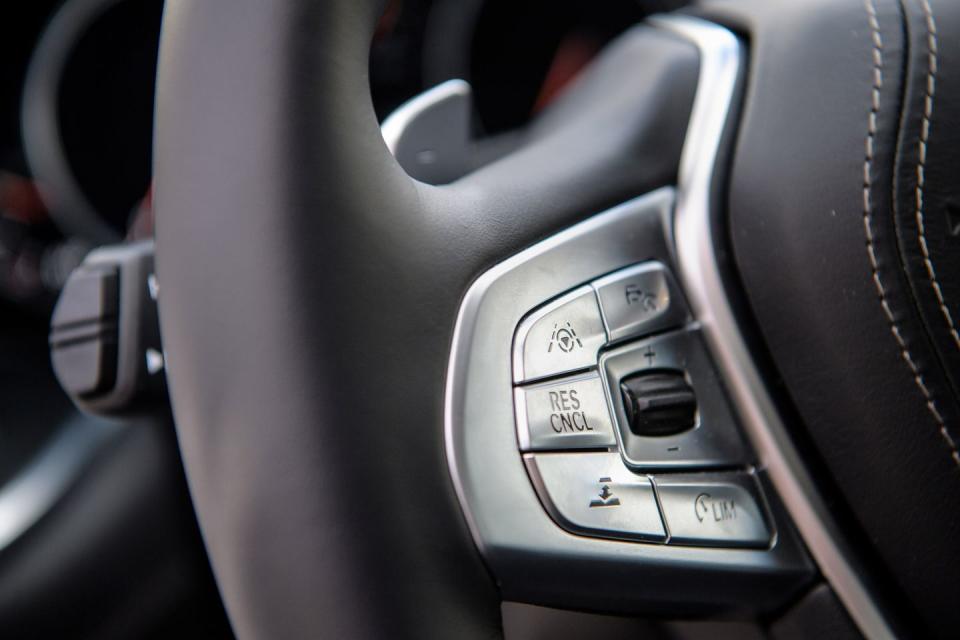How to Use Cruise Control Safely

Sixty years after Chrysler introduced the novelty of driving without pressing the gas pedal, cruise control is standard on the vast majority of new cars. Like power locks and keyless entry, you may forget it's even there. Cruise control functions essentially as it did on the 1958 Chrysler Imperial, the first car it was offered on, but modern electronics are reinventing this basic convenience. Here's how it operates and how to use it properly.
Its Job Is to Maintain Speed
Cruise control's primary function is to maintain the speed of your choosing, relieving you of needing to keep your foot on the throttle. Virtually all cars on the road today rely on an electronic control module-a computer-to monitor the vehicle's speed and to readjust it as needed to hold the speed you've chosen regardless of the road's gradient.

Know the Controls
You operate cruise control by either a stalk on the steering column or several buttons on the steering wheel. These include an on-off switch; a "set" button to select the speed you want the car to maintain; and buttons or switches marked "+" and "-" that increase or decrease the speed after it has been set, often in 1-mph increments. A "cancel" button disengages the cruise-control system without shutting it off entirely, allowing the car to coast. (Cars with stalk-operated cruise control have a "cancel" position that you move the stalk to in order to disengage the system.) A "resume" function or button brings the car back to its previously set speed. Braking or depressing the clutch at any time will also cancel cruise control. Should you need to make a quick pass, you can always override the preset speed by simply pressing down further on the gas pedal.
Adaptive Cruise's Added Features
Many newer cars offer what's known as adaptive cruise control, sometimes also called active cruise. It works in the same way as conventional cruise systems and additionally relies on front-mounted radar, cameras, or sensors to detect the presence of vehicles directly ahead in your lane. This enables adaptive cruise-control systems to maintain a set distance from the vehicle in front no matter how it varies its speed.

Adaptive systems allow you to adjust how closely your vehicle follows the one ahead but are programmed so that they always maintain at least a safe minimum following distance. Some of these systems also have the ability to brake and even come to a complete stop in city traffic and, depending on the vehicle, automatically accelerate without the driver pressing the gas pedal when traffic starts to move again.
Semi-Autonomous Cruise Control
Finally, the newest, most advanced cruise control systems, such as such as Nissan ProPilot Assist, Subaru EyeSight, and Audi Traffic Jam Assist, are semi-automated driving assistants that combine adaptive cruise control with lane-keeping assist, which self-steers the car gently to keep it in lane if you let it wander out-although you can only take your hands off the wheel for a few seconds before the system sounds alarms and then shuts off.
Most of these systems also can autonomously negotiate only the most gentle curves on the interstate. Some semi-autonomous systems, such as those from Tesla and Mercedes-Benz, can do more, including steering the car into the adjacent lane while keeping enough distance from other cars.
Follow These Safety Rules
No matter which type of cruise control your car has, the guidelines for using it effectively and safely are the same:
Always remain alert and aware of other traffic, and be ready to take control and brake or steer around obstacles, inattentive drivers, or emergency situations.
Think of even the most advanced adaptive and semi-autonomous cruise control systems as "dumb." They are programmed by humans and may react unpredictably in certain, unforeseen conditions. (See previous point: "remain alert"). Rain, snow, and fog can obscure radar signals and confuse cameras or sensors, sometimes disabling adaptive cruise control entirely. As with conventional cruise control, with an advanced cruise system you must always be prepared to take full control at a moment's notice.
Cruise control is still best suited for use on highways and in light traffic. If your vehicle has conventional (not adaptive) cruise control, be sure to leave adequate spacing between your car and those ahead, and be prepared to disengage the system by braking or tapping "cancel" as you creep up on other vehicles or get into heavy traffic.
Do not use cruise control in slippery conditions, including snowy or icy roads or rain-soaked roads awash in deep puddles. Most cruise systems will attempt to maintain your speed until you intervene, and on slippery roads that could cause you to momentarily lose traction, upsetting the car and potentially precipitating an accident.
Treat cruise control as a simple labor-saving convenience, however-but one that must be monitored-and you'll enjoy many miles of comfortable, stress-free travel.
('You Might Also Like',)

